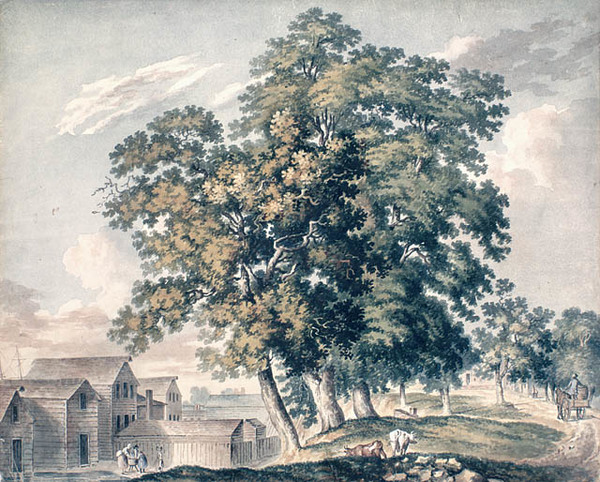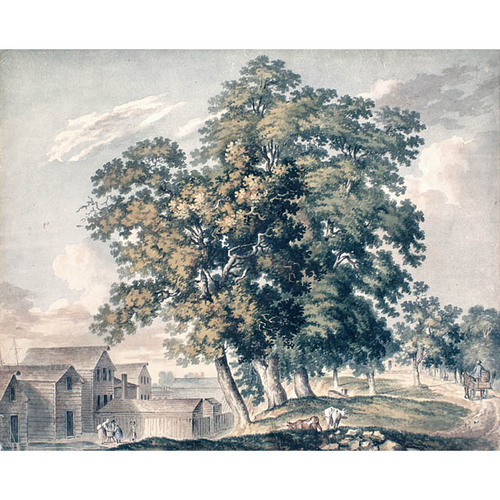
Source: Courtesy of Wikimedia Commons
HAMILTON, JAMES, educator, painter, and businessman; b. 1810, likely in London, England, son of James Matthew Hamilton and Louisa Jupp; m. 4 Sept. 1833 Eliza Hill in York (Toronto), and they had two sons and two daughters; d. 27 Oct. 1896 in London, Ont.
The son of a former army officer, James Hamilton moved with his family from London to St Austell, Cornwall, around 1812. At age eight he was sent to a boarding-school near London; after several years there he attended school in St Austell. In 1829 the family immigrated to Upper Canada, settling in Matchedash Township, near Penetanguishene; James stayed behind to complete his education. About a year later he settled in York, where he ran a preparatory school for boys. By 1834 he was working as a teller in a local bank. During his spare time he was active as a painter in oil and water-colour, eventually developing a reputation as one of the city’s more accomplished amateurs. Although nothing is known about his formal training in art, he is said to have had the most advanced education of all the Hamilton children, one that presumably included private instruction in drawing and water-colour painting.
Hamilton’s earliest involvement with Toronto’s burgeoning art life occurred in 1834, when he became affiliated with the ambitious but short-lived Society of Artists and Amateurs of Toronto, the city’s first organized group of artists. In addition to serving on the committee of management, as an “Associated Artist” he submitted seven landscapes in oil and water-colour to the society’s sole exhibition, held that July. Several of his works, which included original compositions as well as copies after old masters, were praised by local commentators who, although they criticized his use of colour, were highly impressed by his skills as a draftsman.
Despite the demise of the society and the lack of local and regional exhibition facilities, Hamilton continued to paint throughout the 1830s and 1840s, drawing his subject-matter from the local landscape. In the tradition of pre-confederation painting he combined elements of the picturesque with a topographical approach. He also took an interest in subtle atmospheric effects. His work, notably his watercolours, was also characterized by accuracy of form and meticulous attention to detail. Indeed, Hamilton’s abilities as a draftsman were well known – on at least one occasion, around 1835, he was commissioned by a local architect, John George Howard*, to render the landscape background on one of his designs.
In the meantime, Hamilton’s career in the banking world was progressing steadily. Early in 1837 he joined the Bank of Upper Canada [see Thomas Gibbs Ridout*] as an accountant. He remained there until 1844 when he moved to London, Upper Canada, taking up the position of cashier (general manager) at a branch of the same institution. His new responsibilities in London may have allowed him less time for his art – he submitted only two pictures, both landscapes, to the 1847 exhibition of the Toronto Society of Arts. He did not contribute to the society’s second, and final, exhibition of 1848.
Throughout the later 1840s and the 1850s, Hamilton became a leading figure in London business circles. In addition to his work at the bank he served as secretary-treasurer of the Proof Line Road Company and as an agent for the Equitable Fire Insurance Company of London, England, and the National Loan Fund Life Assurance Society. An Anglican, he was an active member of St Paul’s Cathedral, serving from 1870 as church warden, representative to synod, and member of various committees. He remained with the Bank of Upper Canada until shortly before its closure, by bankruptcy, in 1866. An astute businessman, he promptly purchased its newly vacated building and converted it into his own residence, Holmbank, where he lived until his death.
Although Hamilton had private business interests after leaving the bank, his retirement did allow him more time to paint. Adhering to his earlier topographical style, he produced numerous views of Middlesex County which he occasionally displayed at the art exhibitions held with the annual Western Fair. In 1890 he became a member of the Western Art League; however, his submissions to its annual exhibitions were also sporadic. By this time his transcriptive renditions of local views might have been seen as outmoded in comparison with the more contemporary approach of his younger colleagues, such as Paul Peel, who looked not to the British tradition but to French trends, namely academic realism and impressionism, for aesthetic inspiration.
Despite the fact that Hamilton worked outside mainstream artistic developments during his later years and was, throughout his career, a “Sunday painter,” his artistic contribution is important, notably in terms of regional art activity. His deft, technically superb depictions of landscapes in York and Middlesex counties exemplify, especially during the pre-confederation years, the growing interest in native scenery and the strong reliance on British models. Through his involvement with Canada’s earliest art societies he helped nurture a gradually developing artistic community and a sense of professionalism among artists, a direct outgrowth of the political, economic, and social stabilization of Upper Canada. At the time of his death Hamilton left an art collection which included works by such noted British painters as George Morland and Sir Godfrey Kneller.
Public collections holding works by James Hamilton include the NA, Documentary Art and Photography Division; MTRL, Hist. Picture Coll.; and, in London, Ont., the London Hist. Museums, the London Regional Art Gallery, and the UWOL, Regional Coll. Reproductions of his work appear in Archibald Bremner, City of London, Ontario, Canada: the pioneer period and the London of to-day (London, 1900; repr. 1967), 14, 25, 36, 40, 48, 52, 128 (p.25 includes a photograph of the painter); W. M. E. Cooke, W. H. Coverdale Collection of Canadiana: paintings, water-colours and drawings (Manoir Richelieu collection) (Ottawa, 1983), no.208; and D. [R.] Reid and Joan Vastokas, From the four quarters: native and European art in Ontario, 5000 BC to 1867 AD (exhibition catalogue, Art Gallery of Ontario, Toronto, 1984).
Church of Jesus Christ of Latter-Day Saints, Geneal. Soc. (Salt Lake City, Utah), International geneal. index. MTRL, J. G. Howard papers,
Cite This Article
Carol Lowrey, “HAMILTON, JAMES,” in Dictionary of Canadian Biography, vol. 12, University of Toronto/Université Laval, 2003–, accessed December 21, 2024, https://www.biographi.ca/en/bio/hamilton_james_12E.html.
The citation above shows the format for footnotes and endnotes according to the Chicago manual of style (16th edition). Information to be used in other citation formats:
| Permalink: | https://www.biographi.ca/en/bio/hamilton_james_12E.html |
| Author of Article: | Carol Lowrey |
| Title of Article: | HAMILTON, JAMES |
| Publication Name: | Dictionary of Canadian Biography, vol. 12 |
| Publisher: | University of Toronto/Université Laval |
| Year of publication: | 1990 |
| Year of revision: | 1990 |
| Access Date: | December 21, 2024 |



